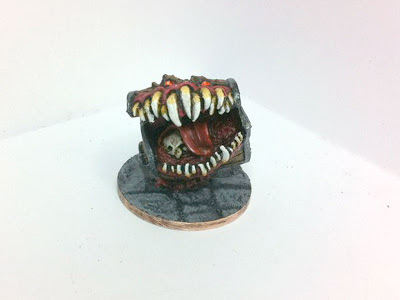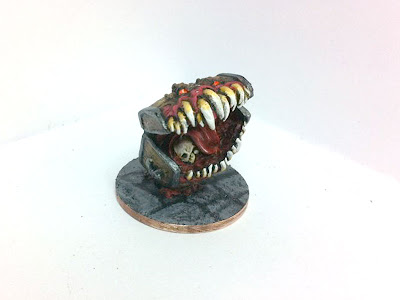The next milestone of this marathon painting challenge is the kobolds.
Just like the
Giant Rats I painted last time, these are one of the monsters in my
Monster Mini Box: Level One and are a classic low level minion and dungeon pest.
Lots of people have gone before and written heaps about
The Ecology of Kobolds, how they are
Reimagining Kobolds and even how
Kobolds are the D&D equivalent of Star Wars Jawas. I'm not going to be going into that level of detail about their origins or whether or not they're the offspring of dogs and dragons (unlikely). Suffice to say that my kobolds are both, they share some draconicon physionomy as well as canine.
They are hairless scaly bipeds with tails, their dog-like heads have vestigial horns and spine crests. Their tails are not prehensile being used primarily for balance and as a way of conveying emotion. The skin on their abdomens and upper tail is much thinner (and of a different colour) to that on the rest of their body. They can be any colour (just like the various hues of dragonkind) but the ones I'm painting today are red.
They are scavengers and any weapons or armour they use is cobbled together from items lost or discarded on battlefields or at the roadside. In fact it is not unheard of for them to scavenge from the edge of a battlefield during the night, despatching any dying soldiers in order to loot their bodies. During research I discovered that there was a 17th century expression
"to laugh like a kobold" so now mine laugh nervously like Muttley.
The 4 Stages of a Miniature Paintjob
Stage 1 - Primer - As I've said before I like to paint over a black basecoat which helps me to build up the layers of colour from dark to light. I use an acrylic car primer in a spray can, and any areas that get missed like undercuts can be touched up later.
Stage 2 - Basecoat - Blocking out the colour areas on a figure with base coat helps you to pre-visualize a colour scheme (ie: work out where your contrasting colours need to go), what your midtones and highlights need to be and finally avoids any need to blackline.
Stage 3 - Midtones - Pick out your midtones by painting smaller areas of colour within the basecoat patches you applied earlier. Midtones are usually halfway between your basecoat colour and your highlight colour and should match the colour of any material or skin your are trying to simulate. For example if you are going for a woodland green cloak, then your colours will be:
- Black Primer
- Basecoat - Woodland Green + Black, Navy Blue or Brown)
- Midtone - Woodland Green
- Highlights - Woodland Green + White, Grey or Yellow
A well stocked range of colours will enable you to paint "straight from the pot" as it were, without any need to mix colours together. This is very important when painting large numbers of the same figure as you'll end up spending the majority of your time mixing colours. Acrylic dries pretty fast so remember kids if you're using Dad's paints (or Mom's,
cos girls likes gaming too) blob a reasonable amount on your palette, don't actually use the pot lid to paint from, you could knock it over or worse end up with the pot lid getting all gunky, losing it's seal and drying out entirely.
Stage 4 - Highlights - Pick out your highlights in the same way as your midtones by painting even smaller patches inside your midtone patches. The effect you are after is a subtle shift in shade from black all the way to your highlight colour. If it looks too "stripey" then your colours probably need to be closer together in shade.
Stand Back and Admire your Handiwork
Remember it's a gaming miniature, for gaming, as long as it looks okay at "stand off scale then "jobs a good'un". If you get good at painting there are plenty of people who will pay good money to get you to paint their armies.
Kobolds x6 (Ben Siens SKU: 77010)
 |
| A dozen Kobolds, enough to challenge any 1st level party |
A Word about Variety
The Bones Kobold miniatures are all well and good, there's a dozen of them (frankly enough to enable me to meet my Appendix C requirement of 6-18) but there are only 3 sculpts (Kobold with; Sword and Shield, Sword and Spear, or just a Spear). When gaming you need something to identify each minion and if you can't do it by their pose, you have to resort to other means such as painting something a particular colour, in the Bones Kobold's case they're either holding a shield, or wearing a waistcoat or mantle.
I've therefore painted a version of each sculpt in each of 4 colours, enabling my players to identify the target of their attack as "Red Shield" or "Blue Mantle" rather than me needing to paint or stick numbers on them (a less visually pleasing option).
 |
3 Bones Kobold sculpts in 4 different colour combinations (Purple, Brown, Blue & Green)
gives me 12 uniquely identifiable minis. A much better system than adding numbers IMHO. |
Oh and if you look closely you'll see that one of them has left behind a little present...
 |
| You can tell this Kobold's shit scared. |
Bones Progress
Reaper Bones: 245 - Painted: 24
Related Posts:































